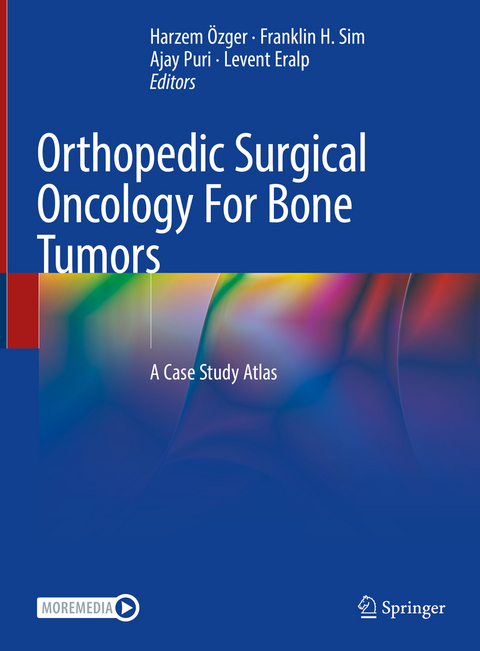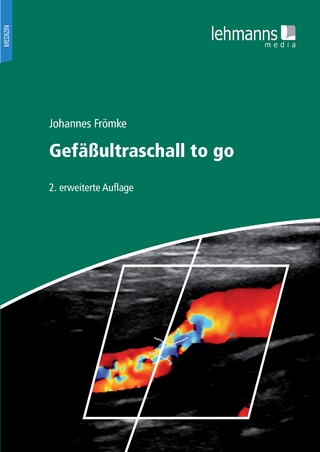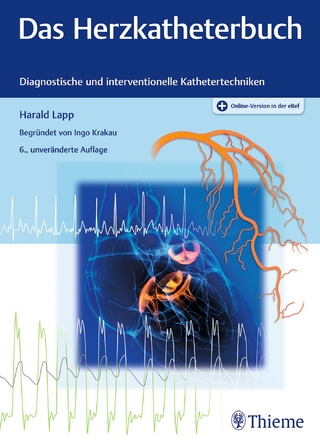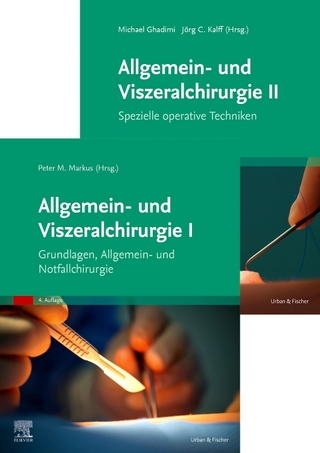
Orthopedic Surgical Oncology For Bone Tumors
Springer International Publishing (Verlag)
978-3-030-73326-1 (ISBN)
The book is designed to actively involve the reader, making it an invaluable tool for all orthopedic surgeons confronted with oncologic surgery. The book is intended for trainees in orthopedics, orthopedic oncology fellows as well as practicing consultants.
lt;p>Dr. Harzem Özger graduated from the medical school at Istanbul University Istanbul Faculty of Medicine in 1979. He completed his residency training in the Dept. of Orthopaedics and Traumatology of the same institution in 1984 with his thesis on "Resurfacing Arthroplasty in Hip Surgery", which was based on his studies in Istanbul, Berlin and Heidelberg. In 1989, he gained experience in tumor surgery at the Medical University of Vienna's Dept. of Orthopaedics, under the supervision of Prof. Rainer Kotz. Upon his return to Istanbul, he established the "Bone and Soft Tissue Tumors" registry at his home clinic. After becoming an Associate Professor in 1990, he worked almost exclusively in the field of orthopedic oncology and received a full professorship in 1996. His clinical practice and research focus on biological reconstruction using vascular fibula and liquid nitrogen recycled autografts, nonbiological reconstruction with tumor prosthesis, spinopelvic tumor surgery, extreme limb salvage in massive or recurrent tumors utilizing radiotherapy, complex foot reconstruction after tumor resection, limb lengthening and deformity correction and wound management in orthopedic oncology. Since his retirement from Istanbul University in 2016, he has continued his private practice and academic work as the head of Istanbul Orthopedic Oncology Group. He is a member of the Turkish Musculoskeletal Tumour Society (TMTS), International Society of Limb Salvage (ISOLS), European Musculoskeletal Oncology Society (EMSOS), Asia Pacific Musculoskeletal Tumour Society, Musculoskeletal Tumor Society (MSTS) and International Skeletal Society (ISS).
Franklin H. Sim graduated from Dalhousie University Medical School in 1964. He completed his orthopedic residency training at Mayo Clinic and was inspired by Dr. Jack Ivins in the area of musculoskeletal oncology. Dr. Sim became a leading innovator and proponent of limb sparing surgery in patients with bone and soft tissue tumors in the 1970s. He was a founding member of the Musculoskeletal Tumor Society and has been active in the International Society of Limb Salvage (ISOLS) and the International Skeletal Society (ISS). Doctor Sim has been a member of the Mayo Clinic faculty for the past 47 years, and he has trained hundreds of residents and more than 50 orthopedic oncology fellows from the United States and overseas.Dr. Ajay Puri is currently Professor and Head of Surgical Oncology, Chief of Orthopaedic, Oncology and Head of the Tissue Bank at Tata Memorial Centre, Mumbai, India. He served as President of the Asia Pacific Musculoskeletal Tumor Society, Founder President of the Indian Musculoskeletal Oncology Society and as past Chairman of the Indian Orthopaedic Association (Oncology). He is also Professor (courtesy faculty) of Materials Science and Engineering at the Department of Materials Science & Engineering, College of Engineering, University of North Texas, USA. He is actively involved in clinical, biomedical and basic research and is the principal investigator in many studies. He is a member of the Global Steering Committee of the International Sarcoma Kindred Study (ISKS), the largest multi institutional international trial aimed at understanding the genetic background of sarcomas. He has developed a low cost indigenous megaprosthesis for limb salvage after oncologic reconstruction that is now extensively used in the country and other Asian and African nations and has also pioneered and popularised novel methods of biological reconstruction after oncologic resection. He serves on the editorial board of Bone & Joint Journal (formerly JBJS.Br.), Bone & Joint-360, Bone & Joint - Open, Sarcoma and Frontiers in Orthopedic Surgery and has published more than a hundred and fifty papers as well as numerous book chapters.
Dr. Levent Eralp attended medical school at Istanbul Universi
lt;p>Part 1: Philosophy of limb salvage surgery
1. When and why biological/ implant reconstruction?
Part 2: Mobile Spine
2. Biological reconstruction using frozen autograft in total en bloc spondylectomy for spinal tumors
3. Implant Reconstruction of the Mobile Spine
Part 3: Sacrum
4. Biological Sacral Reconstruction
5. Total Sacrectomy without Spinopelvic Reconstruction
6. Implant Reconstruction of the Sacrum: modular sacrum prosthesis
Part 4: Pelvis
7. Biological Reconstruction of the Pelvis - I: liquid nitrogen treated autograft & onlaid free vascular fibula
8. Biological Reconstruction of the Pelvis - II: femoral head plus total hip replacement
9. Implant Reconstruction of the Pelvis - I: modular hemipelvic prosthesis
10. Implant Reconstruction of the Pelvis - II: modular pedestal cup prosthesis
11. Implant Reconstruction of the Pelvis - III: high acetabular placement & prosthetic femoral extension
12. Implant Reconstruction of the Pelvis - IV: 3D-printed custom-made prosthesis
Part 5: Proximal femur
13. Biological Reconstruction of the Proximal Femur With extracorporeally irradiated autograft
14. Implant Reconstruction of the Proximal Femur: Modular Prosthesis
15. Prosthetic reconstruction for soft tissue sarcomas with bone involvement
Part 6: Femoral diaphysis
16. Biological Reconstruction of the Femoral Diaphysis: Van Nes rotationplasty
17. Implant Reconstruction of the Femoral Diaphysis - I: intercalary femur prosthesis
18. Implant Reconstruction of the Femoral Diaphysis - II: short-segment dynamic-compression stem
19. Implant Reconstruction of the Femoral Diaphysis - III: percutaneous ossoeintegrated prosthesis
Part 7: Distal femur
20. Biological Reconstruction of the Distal Femur - I: massive allograft & inlaid free vascular fibula21. Biological Reconstruction of the Distal Femur - II: resurfacing allograft-prosthesis composite
22. Biological Reconstruction of the Distal Femur - III: liquid nitrogen treated autograft & inlaid free vascular fibula (the "frozen hotdog")
23. Implant Reconstruction of the Distal Femur - I: modular prosthesis
24. Implant Reconstruction of the Distal Femur - II: joint-preserving resection & reconstruction with image-guided computer navigation
25. Implant Reconstruction of the Distal Femur - III: expandable prosthesis
26. Implant Reconstruction of the Distal Femur - IV: prosthesis revision
Part 8: Proximal tibia
27. Biological Reconstruction of the Proximal Shaft of Tibia - I: Pedicle frozen autograft
28. Biological Reconstruction of the Proximal Tibia - II: Distraction-Epiphysiolysis before resection of the tumor
29. Implant Reconstruction of the Proximal Tibia: modular prosthesis rotational gastrocnemius flap
Part 9: Tibial diaphysis and ankle
30. Biological Reconstruction of the Tibial Diaphysis & Ankle - I: Ilizarov technique
31. Biological Reconstruction of the Tibial Diaphysis & Ankle - II: fibular centralization technique
32. Biological Reconstruction of the Tibial Diaphysis & Ankle - III: arthrodesis with massive allograft
33. Implant Reconstruction of the Tibial Diaphysis & Ankle: 3D-printed custom-made prosthesis
Part 10: Foot
34. Biological Reconstruction of the Foot free vascular iliac flap35. Implant Reconstruction of the Foot 3D-printed custom-made prosthesis
Part 11: Shoulder girdle
36. Biological Reconstruction of the Shoulder Girdle - scapular massive allograft
37. Implant Reconstruction of the Shoulder Girdle: scapular prosthesis
Part 12: Proximal humerus
38. Proximal Humerus, Biological Reconstruction
39. Claviculo-Pro-Humero reconstruction following proximal humeral resection for sarcoma40. Biological Reconstruction of the Proximal Humerus - III massive allograft & inlaid free vascular fibula with epiphyseal transfer
41. Implant Reconstruction of the Proximal Humerus
42. Implant Reconstruction of the Proximal Humerus - II: reverse prosthesis
Part 13: Humeral diaphysis
43. Biological Reconstruction of the Humeral Diaphysis: irradiated autograft
44. Implant Reconstruction of the Humeral Diaphysis: total humerus prosthesis
Part 14: Distal humerus & elbow
45. Implant Reconstruction of the Distal Humerus & Elbow - modular prosthesis
Part 15: Forearm, wrist & hand
46. Biological Reconstruction of the Forearm, Wrist & Hand - I: free vascular fibula
47. Biological Reconstruction of the Forearm, Wrist & Hand - II: transposition of the distal ulna
48. Implant Reconstruction of the forearm, wrist, and hand - Distal Radius Endoprosthesis
Part 16: Complications of orthopedic oncologic reconstructions
49. Biological
50. Implant
| Erscheinungsdatum | 04.12.2021 |
|---|---|
| Zusatzinfo | XIII, 583 p. 571 illus., 363 illus. in color. With online files/update. |
| Verlagsort | Cham |
| Sprache | englisch |
| Maße | 210 x 279 mm |
| Gewicht | 1974 g |
| Themenwelt | Medizinische Fachgebiete ► Chirurgie ► Herz- / Thorax- / Gefäßchirurgie |
| Medizinische Fachgebiete ► Chirurgie ► Unfallchirurgie / Orthopädie | |
| Schlagworte | biological reconstruction • bone defect • endoprosthetics reconstruction • Limb Salvage • musculoskeletal malignancy • Soft tissue reconstruction |
| ISBN-10 | 3-030-73326-2 / 3030733262 |
| ISBN-13 | 978-3-030-73326-1 / 9783030733261 |
| Zustand | Neuware |
| Haben Sie eine Frage zum Produkt? |
aus dem Bereich


